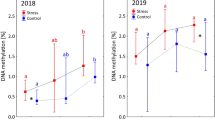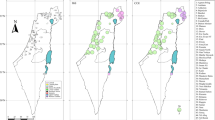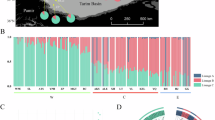Abstract
Allozyme diversity in the superspecies Spalax ehrenbergi has been revisited by studying 36 gene loci in 241 subterranean mole rats from 22 populations and nine chromosomal species, four from Turkey (2n = 52E (east), 52W (west), 56 and 58), four from Israel (2n = 52, 54, 58 and 60), and one from Egypt (2n = 60). The following results were indicated. (1) Genetic patterns: 11 of the 36 loci analysed (30.5 per cent) were monomorphic across the range, fifteen (41.7 per cent) were weakly polymorphic and the remaining 10 loci (27.8 per cent) were strongly polymorphic. (2) Heterozygosity: the average H was 0.051, range 0.00–0.098. In Israel, H increased with aridity and climatic unpredictability towards the northern Negev Desert, and was remarkably high in small steppic semi-isolates and desert isolates. (3) Species discrimination: some of the S. ehrenbergi species can be discriminated qualitatively. (4) Genetic distances (D): between species these values averaged 0.077, range 0.001–0.269, with the highest D between the ancestor Turkish and descendant Israeli and Egyptian species. The phylogenetic tree supports the Turkish origin of the Israeli Spalax ehrenbergi species, and the recent speciation of the Egyptian Spalax. (5) Genetic diversity is mostly (58 per cent) within populations. (6) Allozyme correlates: allozyme diversity was significantly correlated with the external physical (both climatic and edaphic) and biotic (parasite infection and plant cover) environment. (7) Spatial autocorrelation of allozyme frequencies suggests that migration is not influential. (8) Gametic phase disequilibria were significant in four out of five species tested, and were associated with climatic and edaphic factors. These results support the environmental selection hypothesis of genetic diversity including the niche-width variation hypothesis in space and time. Natural selection appears to play a major role in genetic differentiation of proteins in adaptive radiation and speciation.
Similar content being viewed by others
Article PDF
References
Atlas of Israel. 1970. Surveys of Israel. Ministry of Labour, Jerusalem and Elsevier, Amsterdam.
Ben-Shlomo, R, Shin, H-S, and Nevo, E. 1993. Period-homologous sequence polymorphisms in subterranean mammals of the Spalax ehrenbergi superspecies in Israel. Heredity, 70, 111–121.
Burda, H, Filippucci, M G, Macholan, M, Nevo, E, and Zima, J. 1992. Biological, allozyme, and karyotype differentiation of African mole-rats (Cryptomys, Bathyergidae) from Zambia. Z Saugetierk Suppl, 57, 11–12.
Catzeflis, F M, Nevo, E, Ahlquist, J E, and Sibley, C G. 1989. Relationships of the chromosomal species in the Eurasian mole rats of the Spalax ehrenbergi group as determined by DNA-DNA hybridization, and an estimate of the spalacid-murid divergence time. J Mol Evol, 29, 223–232.
Felsenstein, J. 1991. PHYLIP (Phytogeny Inference Package) manual of Version 34. Distributed by the author. University of Washington, Seattle.
Filippucci, M G, Nascetti, G, Capanna, E, and Bullini, L. 1987. Allozyme variation and systematics of European moles of the genus Talpa (Mammalia, Insectivora). J Mammal, 68, 487–499.
Filippucci, M G, Hickman, G C, Capanna, E, and Nevo, E. 1991. Genetic diversity and differentiation of the endemic subterranean golden moles of South Africa (Chrysochloridae, Mammalia). Biochem Syst Ecol, 19, 461–466.
Gillespie, J. 1991. The Causes of Molecular Evolution. Oxford University Press, New York.
Gorman, G C, and Renzi, J. JR. 1979. Genetic distance and heterozygosity estimates in electrophoretic studies: effects of sample size. Copeia, 1979, 242–249.
Honeycutt, R L, Nelson, K, Schlliter, D A, and Sherman, P W. 1991. Genetic variation within and among populations of the Naked mole-rat: Evidence from nuclear and mitochondrial genomes. In: Sherman, P. W., Jarvis, J. U. M. and Alexander, R. D. (eds) The Biology of the Naked Mole-Rat, pp. 195–208. Princeton University Press, Princeton, NJ.
Kimura, M. 1983. The Neutral Theory of Molecular Evolution. Cambridge University Press, Cambridge.
Nei, M. 1971. Interspecific gene differences and evolutionary time estimated from electrophoretic data on protein identity. Am Nat, 105, 385–398.
Nei, M. 1972. Genetic distance between populations. Am Nat, 106, 283–292.
Nei, M. 1973. Analysis of gene diversity in subdivided populations. Proc Natl Acad Sci USA, 70, 3321–3323.
Nei, M. 1978. Estimation of average heterozygosity and genetic distance from a small number of individuals. Genetics, 89, 583–590.
Nevo, E. 1978. Genetic variation in natural populations: Patterns and theory. Theor Pop Biol, 13, 121–177.
Nevo, E. 1979. Adaptive convergence and divergence of subterranean mammals. Ann Rev Ecol Syst, 10, 269–308.
Nevo, E. 1983. Population genetics and ecology: the interface. In: Bendall, D. S. (ed.) Evolution from Molecules to Men, pp. 287–321. Cambridge University Press, Cambridge.
Nevo, E. 1985. Ecological and populational correlates of allozyme polymorphisms in mammals. Acta Zool Fenn, 170, 25–29.
Nei, M. 1987. Molecular Evolutionary Genetics. Columbia University Press, New York.
Nevo, E. 1988a. Genetic diversity in nature: Patterns and theory. Evol Biol, 23, 217–246.
Nevo, E. 1988b. Natural selection in action: The interface of ecology and genetics in adaptation and speciation at the molecular and organismal levels. In: Tchernov, E. and Yom-Tov, Y. (eds) Zoogeography of Israel, pp. 411–438. Dr. Junk Publications, Holland.
Nevo, E. 1989. Modes of speciation: The nature and role of peripheral isolates in the origin of species. In: Giddings, L. V., Kaneshiro, K. Y. and Anderson, W. W. (eds) Genetics, Speciation and the Founder Principle, pp. 205–236. Oxford University Press, Oxford.
Nevo, E. 1991. Evolutionary theory and processes of active speciation and adaptive radiation in subterranean mole rats; Spalax ehrenbergi superspecies, in Israel. Evol Biol, 25, 1–125.
Nevo, E, and Shaw, C R. 1972. Genetic variation in a subterranean mammal, Spalax ehrenbergi. Biochem Genet, 7, 235–241.
Nevo, E, and Cleve, H. 1978. Genetic differentiation during speciation. Nature, 275, 125–126.
Nevo, E, and Beiles, A. 1988. Genetic parallelism of protein polymorphism in nature: ecological test of the neutral theory of molecular evolution. Biol J Linn Soc, 35, 229–245.
Nevo, E, and Beiles, A. 1989. Genetic diversity in the desert: Patterns and testable hypotheses. J Arid Env, 17, 241–244.
Nevo, E, and Reig, O A. (eds) 1990. Evolution of Subterranean Mammals at the Organismal and Molecular Levels. Alan R. Liss, Inc., New York.
Nevo, E, and Beiles, A. 1991. Genetic diversity and ecological heterogeneity in amphibian evolution. Copeia, 3, 565–592.
Nevo, E, and Beiles, A. 1992. MtDNA polymorphisms: evolutionary significance in adaptation and speciation of subterranean mole rats. Biol J Linn Soc, 47, 385–405.
Nevo, E, Kim, Y J, Shaw, C R, and Thaeler, C S. Jr. 1974. Genetic variation, selection and speciation in Thomomys talpoides pocket gophers. Evolution, 28, 1–23.
Nevo, E, Heth, G, and Beiles, A. 1982. Population structure and evolution in subterranean mole rats. Evolution, 36, 1283–1289.
Nevo, E, Beiles, A, and Ben-Shlomo, R. 1984. The evolutionary significance of genetic diversity: ecological, demographic and life history correlates. In: Mani, G. S. (ed.) Evolutionary Dynamics of Genetic Diversity. Lect. Notes Biomath., 53, 13–213.
Nevo, E, Corti, M, Ben-Shlomo, R, Beiles, A, Jarvis, J U M, and Hickman, G C. 1985a. Karyotype and allozyme differentiation in the endemic subterranean mole rats of Africa, the Bathyergidae. In: Abstr 4th Int Ther Congr, Edmonton, Alberta, p. 460.
Nevo, E, Beiles, A, and Ben-Shlomo, R. 1985b. Genetic diversity and differentiation in mammals. In: Abstr 4th Int Ther Congr, Edmonton, Alberta, p. 459.
Nevo, E, Ben-Shlomo, R, Beiles, A, Jarvis, J U M, and Hickman, G C. 1987. Allozyme differentiation and systematics of the endemic subterranean mole rats of South Africa (Rodentia, Bathyergidae). Biochem Syst Ecol, 15, 489–502.
Nevo, E, Filippucci, M G, Simson, S, and Heth, G. 1989. Karyotype and allozyme differentiation in the Spalax leucodon superspecies from Turkey. In: Abstr 5th Int Ther Congr Rome, p. 26.
Nevo, E, Filippucci, M G, and Beiles, A. 1990. Genetic diversity and its ecological correlates in nature: Comparisons between subterranean, fossorial, and aboveground small mammals. In: Nevo, E. and Reig, O. A. (eds) Evolution of Subterranean Mammals at the Organismal and Molecular Levels, pp. 347–366. Alan R. Liss, Inc., New York.
Nevo, E, Simson, S, Heth, G, Redi, C, and Filippucci, M G. 1991. Recent speciation of subterranean mole rats of the Spalax ehrenbergi superspecies in the El-Hammam isolate, northern Egypt. 6th International Colloquium on the Ecology and Taxonomy of Small African Mammals, Mitzpe Ramon, Israel, p. 43.
Nevo, E, Ben-Shlomo, R, Beiles, A, Hart, C P, and Ruddle, F H. 1992. Homeobox DNA polymorphisms (RFLPs) in subterranean mammals of the Spalax ehrenbergi superspecies in Israel: Patterns, correlates and evolutionary significance. J Exp Zool, 263, 430–441.
Nevo, E, Honeycutt, R L, Yonekawa, H, Nelson, K, and Hanzawa, N. 1993. Mitochondrial DNA polymorphisms in subterranean mole rats of the Spalax ehrenbergi superspecies in Israel and its peripheral isolates. Mol Biol Evol, 10, 590–604.
Patton, J L. 1990. Geomyid evolution: The historical, selective, and random basis for divergence patterns within and among species. In: Nevo, E. and Reig, O. A. (eds) Evolution of Subterranean Mammals at the Organismal and Molecular Levels, pp. 49–69. Alan R. Liss, Inc., New York.
Patton, J L, and Yang, S Y. 1977. Genetic variation in Thomomys bottae pocket gophers: Macrogeographic patterns. Evolution, 31, 697–720.
Patton, J L, and Smith, M F. 1990. The evolutionary dynamics of Thomomys bottae pocket gophers in California. Calif Univ Publ Zool, 123, 1–161.
Sage, R D, Contreras, J R, Roig, V G, and Patton, J L. 1986. Genetic variation in the South American burrowing rodents of the genus Ctenomys (Rodentia: Ctenomyidae). Z Saugetierkunde, 51, 158–172.
Saitou, N, and Nei, M. 1987. The Neighbor-Joining method: A new method for reconstructing phylogenetic trees. Mol Biol Evol, 4, 406–425.
Sarich, V M. 1977. Rates, sample sizes and the neutrality hypothesis for electrophoresis in evolutionary studies. Nature, 263, 24–28.
Savic, I, and Nevo, E. 1990. The Spalacidae: Evolutionary history, speciation, and population biology. In: Nevo, E. and Reig, A. O. (eds) Evolution of Subterranean Mammals at the Organismal and Molecular Levels, pp. 129–153. Alan R. Liss, Inc., New York.
Selander, R K, Kaufman, D W, Baker, R J, and Williams, S L. 1974. Genie and chromosomal differentiation in pocket gophers of the Geomys bursarius group. Evolution, 28, 557–564.
Smith, M H, Charles, T G. JR, and Ramsey, P R. 1975. Genie heterozygosity and population dynamics in small mammals. In: Markert, C. L. (ed.) Isozymes IV, Genetics and Evolution, pp. 85–102. Academic Press, Inc., San Francisco.
Sokal, R R, and Oden, N L. 1978a. Spatial autocorrelation in biology. I. Methodology. Biol J Linn Soc, 10, 199–228.
Sokal, R R, and Oden, N L. 1978b. Spatial autocorrelation in biology. II. Some biological implications and four applications of evolutionary and ecological interest. Biol J Linn Soc, 10, 229–249.
Sokal, R R, and Wartenberg, D W. 1983. A test of spatial autocorrelation using an isolation-by-distance model. Generics, 105, 219–237.
Soulé, M, and Stewart, B R. 1970. The “niche variation” hypothesis: a test and alternatives. Am Nat, 104, 85–97.
SPSS. 1990. SPSS Reference Guide, Release 4, SPSS Inc., Chicago.
Swofford, D L, and Selander, R B. 1989. Manual of BIOSYS-1 Computer Program, Release 17. Distributed by D. L. Swofford, Illionoi's Natural History Survey.
Van Valen, L. 1965. Morphological variation and width of ecological niche. Am Nat, 99, 377–390.
Vithayasai, C. 1973. Exact critical values of the Hardy-Weinberg test statistic for two alleles. Commun Stat, 1, 229–242.
Yates, T L, and Moore, D W. 1990. Speciation and evolution in the family Talpidae (Mammalia: Insectivora). In: Nevo, E. and Reig, O. A. (eds) Evolution of Subterranean Mammals at the Organismal and Molecular Levels, pp. 1–22. Alan R. Liss, Inc., New York.
Author information
Authors and Affiliations
Rights and permissions
About this article
Cite this article
Nevo, E., Filippucci, M. & Beiles, A. Genetic polymorphisms in subterranean mammals (Spalax ehrenbergi superspecies) in the Near East revisited: patterns and theory. Heredity 72, 465–487 (1994). https://doi.org/10.1038/hdy.1994.65
Received:
Issue date:
DOI: https://doi.org/10.1038/hdy.1994.65
Keywords
This article is cited by
-
16S rRNA gene polymorphism supports cryptic speciation within the lesser blind mole rat Nannospalax leucodon superspecies (Rodentia: Spalacidae)
Mammalian Biology (2020)
-
The dimensions, modes and definitions of species and speciation
Biology & Philosophy (2007)



